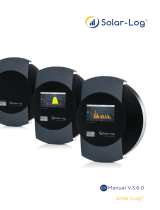Page 10 = Key 1 = Key 2 = Key 3= Maximum or consumption = Minimum or supply.
Putting into service
Auxiliary voltage
The input of the auxiliary voltage (terminals 14, 15) of
the UMG 503 is suitable for rated voltages up to 300VAC
against ground (PE). Higher voltages between auxiliary
voltage and ground can damage the UMG 503. To avoid
overvoltage, auxiliary voltage should be earthed.
Please also note the following:
- The wiring for the auxiliary voltage must be suited for
operating voltage up to 300VAC against ground.
- The auxiliary voltage must be protected with a fuse,
which should be in the range of 2...10A.
- A switch or power breaker must be provided for the
auxiliary voltage within the installation.
- The switch must be installed near the device and must
have an easy access for the user.
- The switch must be marked as a breaker for this device.
- Please ensure, that voltage and frequency match the
type plate before connecting it to the auxiliary voltage!
- The device may be operated with earthed housing only!
- Conductors with single solded wires are not suited for
connection to screw clamps!
- The screw clamps may only be connected in dead
condition.
Measuring voltage
The wires for the measuring voltage must be suitable for
up to 500VAC against ground and 870VAC phase to
phase.
Attention!
For the connection examples 5 and 6, the option "three
wire measurement" is required. In mains without neu-
tral conductor, voltage transformes must be connected
according to the respective connection example.
Testing current
Current transformers of .../5A or .../1A can be connected
directly to the current inputs of the UMG 503.
Attention!
Current transformers can lead voltage, which
can be live and should be earthed.
RS485 Interface cable
Bus structure
All devices are connected in bus structure (line). In one
segment up to 32 participants can be connected. At the
beginning and the end of one segment, the cable is
terminated with resistors. Within the UMG 503, these
resistors can be activated with two plug bridges.
For more than 32 participants, you must use a repeater
(line amplifier) to connect the single segments.
Protection
For the connection via RS485 interface, you must use a
twisted pair and protected cable. To achieve a sufficient
protection result, the protection must be connected to
housing or cabinet parts at both ends of cable with large
surface.
Baudrate (kbit/s)
Cable type 9.6 19.2 93.75 187.5 500 1500
Type A 1200 1200 1200 1000 400 200
Type B 1200 1200 1200 600 200 70
Cable length
The following table shows the maximum cable length in
meter (m) for different baudrates.
Cable specification:
The maximum length depends on cable type and baud-
rate. We recommend type A
Cable parameters Type A Type B
Impedance 135-165Ohm 100-130Ohm
(f = 3-20MHz) (f > 100kHz)
Capacity < 30pF/m < 60pF/m
Resistance < 110 Ohm/km -
Diameter >= 0,34mm2 >= 0,22mm2
(AWG22) (AWG24)
Ꮨ





















